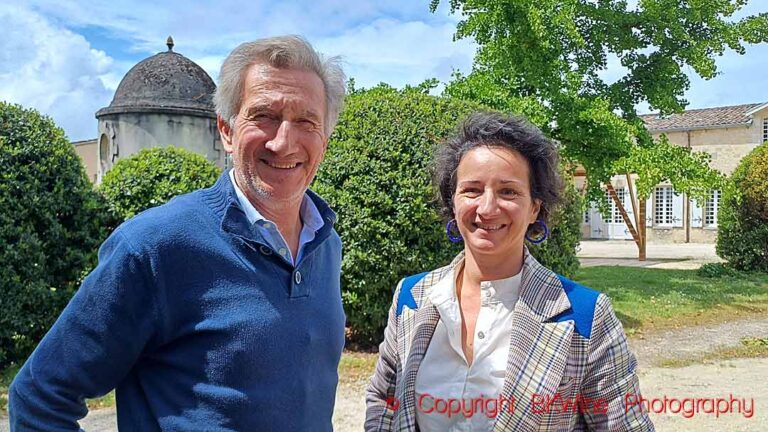Château Raymond-Lafon, the chateau and wine estate of the Meslier family, is next door to the legendary Château d’Yquem. Only a few meters apart, the vineyards differ and both chateaux have the same strict selection and the same vinification and ageing methods. Which is perhaps not so strange: Pierre Meslier was the manager of Yquem between 1963 and 1989. In 1972, he bought Raymond-Lafon and continued to make wine here after retiring from Yquem, in the same spirit as he did at Yquem. But a wine that costs significantly less than the neighbour. Today, the business is run by his children Marie-Françoise, Charles-Henri and Jean-Pierre Meslier.
A number of years ago (2002 in fact) we had the privilege of meeting Pierre Meslier on one of our wine tours in Bordeaux. He took us around the vineyard and the wine cellar. After a day in the company of Monsieur Meslier, it is difficult to understand the huge price difference with the big neighbour. Is Château d’Yquem so much better so that a price five times higher is justified, we wondered? (Today, the price difference has doubled to ten times.)
– Château d’Yquem is much larger in area than Raymond-Lafon. With their 100 hectares, compared to Raymond-Lafon’s 16 ha, they have much greater variation in the soil and this contributes to greater complexity in the wine, said Pierre Meslier. But of course you also pay for the name Yquem which has something of a golden shimmer over it.
Already in 1855, when the Sauternes wines were classified, Yquem stood out from the crowd and was placed in a category of its own, premier grand cru classé. But who knows, maybe that was due to the noble family that owned the chateau at the time. If you look at the list of classified chateau in Sauternes, Raymond-Lafon is missing, which may seem strange, surrounded as it is by classified estates. The explanation is simple. When the classification was made in 1855, Raymond-Lafon had only existed for five years. Raymond-Lafon has no problem being outside the classification, as the chateau has nevertheless made a name for itself as one of the foremost in Sauternes. For example, Raymond-Lafon has been served three times at the Nobel dinners, in 2000, 2004 and 2010. Do you need more proof than that you have succeeded? In 2000 it was with a blueberry sorbet with small almond pastries.
“Of course we were very flattered by this,” said Pierre Meslier. It was a great honour to be chosen and that it was also a year that 2000, with its very special significance, made it feel even greater.
Wrinkled and shrivelled
When we met Pierre Meslier, he was a jovial pensioner, tall, stately and white-haired. We could tell that he still enjoyed himself very much in the vineyard. At the time of our visit, approximately 50 percent of the 2002 harvest had been harvested. The vineyard workers had gone through the vineyard twice and only picked the grapes that were sufficiently rotten. The precious rot is not so kind as to appear at the same time in the entire vineyard…
Monsieur Meslier showed us crumpled and shrivelled sémillon grapes that were soon ready for harvest. They did not look particularly appetizing. But if you dared to taste, they turned out to be really sweet and delicious.
“Sémillon, with its somewhat neutral character, is the grape that is best suited for a Sauternes. It is easily affected by the noble rot and it reaches high sugar levels. Sauvignon blanc is also important, it contributes aromatic character.”
The grapes are harvested at 20–21 percent potential alcohol content. The sugar content is then 360-380 grams per litre. The vineyard workers pick grape by grape, rather than bunch by bunch.
“I have a group of women who faithfully return year after year,” Pierre Meslier said. “Women do this job better because they have smaller fingers.”
The harvest sometimes lasts well into November. An easy year, it takes a total of four or five weeks, a difficult year two months.
“Quality is so important,” said Pierre Meslier, “that we do not hesitate to declassify part of the harvest every year. It can be between 20 and 80 percent of the harvest that we don’t think reaches our standard. Then it is sold as regular Sauternes.”
One glass of wine per vine…
The yield is always less for sweet wines than for dry ones. The statutory maximum yield in Sauternes is 25 hectolitres per hectare. Raymond-Lafon and Yquem are not even close to this. It is usually nine hectolitres per hectare – one glass of wine per vine!
In addition, these two estates are probably more or less alone in Sauternes in ageing their wines in brand new oak barrels for three years, with regular topping up and racking (moving the wine to clean barrels to remove the deposit).
The cellar at Raymond-Lafon is small compared to most others in Bordeaux, but with the low yield, they make no more than 2000 cases per year. The fermentation also takes place in barrels and stops naturally when the alcohol contents reach 13–13.5% by volume. Then there is about 130 grams sugar per litre left.
When we tasted a Raymond-Lafon in 1998, we got proof that the loving treatment gives results. It will last for least 30 years, this fantastically full-bodied wine with plenty of mouth-filling character, exotic fruit, apricot and a refreshing citrus fruit.
“Do not see Sauternes as just a dessert wine,” said Pierre Meslier, “but also drink it as an apéritif, with fish with cream sauce, chicken or veal, with oysters, blue cheese or game. Sauternes is a more versatile wine than you think.”
Now it is up to you to try.


















